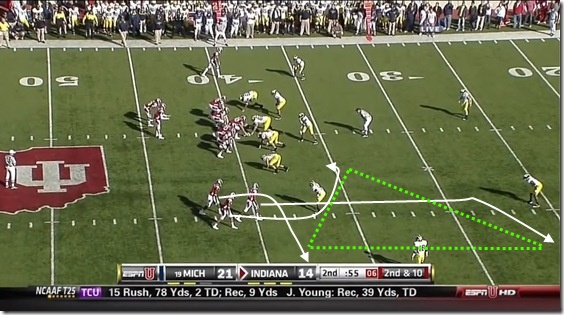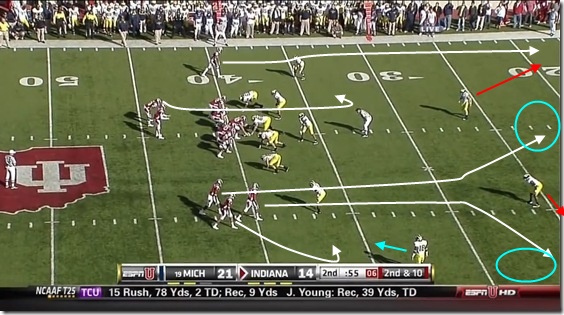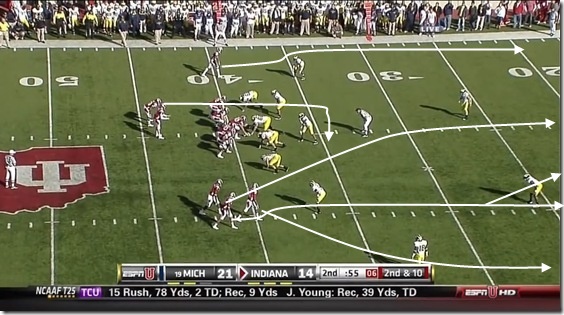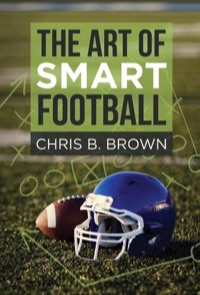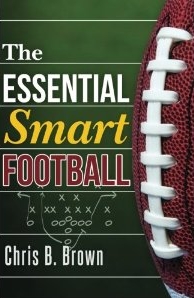Brian Cook of mgoblog put up some photos from last week’s game between Michigan and Indiana, where Michigan pulled out the victory but Indiana’s Ben Chappell threw for 480 yards and three TDs, by completing over 70% of his passes. Most of these yards came from underneath throws, but Chappell hit a few big plays, including a big gainer on third and 16. Brian put up the photo below, followed by much hand-wringing:
Indiana uses the snag route concept to break a man wide open (shown below), and the question arises as to who to blame and if players were out of position. The above photo, however, shows most of what you need to see: you’re probably in trouble. It’s a wide trips bunch (trips but detached from the formation), the corner isn’t in position to get a jam, and you’re outnumbered. Being third and 16 it’s not a given that Indiana could convert, but this defense is not well equipped for the formation. To illustrate, let me flip the question around: If you were IU’s quarterback or offensive coordinator (or if you were Michigan and IU lined up like this against you), what would you call? The answer, most coaches would agree, is most anything you like, especially with the techniques Michigan used.
Counting game. As anyone who reads this site knows, all football begins as arithmetic. Were it not third and 16, the automatic adjustment you’d see against this defensive look is the bubble screen.
This works because of numbers: there are three receivers against two short defenders; the deep safety is not in position to tackle the bubble for a short gain. (And if he is, you use the fake-bubble and go play.) But it was third and 16 so you need to find a way to get the ball down field, or at least give yourself a chance to do so. Indiana called the “snag” concept. The purpose here is to form a triangle read, which is formed by combining a two-man “vertical stretch, i.e. one guy high and one guy low, and a two-man “horizontal stretch,” i.e. one guy outside and one guy inside. As shown in the image, the corner route and the flat route form the high/low portion of the read, while the flat also forms part of the horizontal or out/in stretch, with the slant-sit or snag route forming the other part.
On the actual play, the corner sat on the flat route and the corner route — one on one with the safety who had no help to either the inside or outside, and thus had little chance to make a play — was wide open.
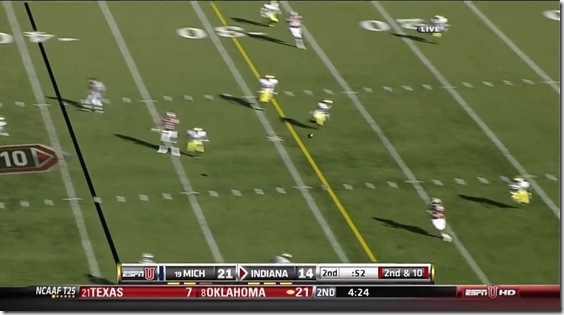
This worked for the same reason the bubble screen worked: the cornerback (one guy) can’t guard two guys (the corner route and the flat route). But let’s say IU wanted to be more aggressive and wanted to attack more than just the corner; let’s say they wanted to put pressure — and get a numbers advantage — against both the cornerback and the safeties. How would they do that? With the trusty smash concept with the divide route.
We all know why Cover Two is called Cover Two: It’s because there are two deep safeties. Thus if you want to break someone downfield, you need to send three guys deep. The great thing about the smash is that you can outnumber the secondary both horizontally across the field (three guys running deep and stretching two deep safeties) but also vertically (high/low of the cornerback).
From bunch, the outside receiver widens on his hitch route to get the corner to widen and then simply breaks down. The backside safety is occupied by the backside split end going deep, and, as a result, the trips side safety has to make a very unfortunate choice between one receiver breaking for the post and another breaking for the corner. (Tampa Two refers to a variation of Cover Two where the middle linebacker drops back to cover the middle of the field; if they use this your speedy receiver might still beat him down the middle, but if not you have the runningback on a checkdown over the middle.) I’d say that if you play Cover Two against trips (which can definitely be done — more on that later), the first thing an opposing coach will try you with is the smash with a divide or seam/post right down the middle.
Now let’s say you are confident that you won’t get much pressure on your passer, and you want to hit a downfield pass, high/low reads be damned. In that case you pick the most aggressive horizontal stretch of them all, four verticals.
When you run this from trips your first read is not the trips side safety, but the backside safety. This is because his first reaction is going to be to the split end to his side; he only has one receiver over there, and if he gets beat down the sideline in Cover Two he won’t be playing very long. But depending on his rules he also is responsible for that inside man in trips, the “number three receiver,” coming across, because the trips side safety has his hands full with the other two guys already (as we’ve shown above). If the safety to the single receiver side widens to the split end, the quarterback hits the receiver coming across the field; this is a Drew Brees special. If either safety squeezes him it should open up one of the other receivers, either the split end or the other seam receiver. This puts a lot of vertical pressure on the safeties, especially with the switch release from bunch as I’ve shown it.
Now let’s say you don’t care about working the backside safety or hitting the touchdown right now: you just want to convert the third down. And let’s say that you aren’t confident that your single receiver can beat the safety one-on-one on a corner route, or that you’re aren’t as sure your quarterback can hit it. Go back to your basic arithmetic: they have two guys (a safety deep and a cornerback shallow), so you can attack them with three receivers: the flood or sail concept.
On this concept, the outside man goes deep, and the deep safety ought to take him. For an example of trips flood where the safety did not take the deep man, see this clip of Notre Dame versus Michigan, courtesy again of the invaluable Brian Cook:
As evident in the image and the video, a second receiver runs a deep out or corner, while a third runs to the flat. (You can play around with who does what; it’s only important that someone get to each area to stretch the defense.) The quarterback uses a simple progression read — deep, medium, short — to find the open receiver. Moreover, one of the great things about this concept is that you can roll out your quarterback, thus shortening the throw for a guy who might not have enough of a cannon to throw the deep out.
I didn’t choose this example to pick on Michigan (I’m serious, I really didn’t), but instead to do two things. First, to show that this defense doesn’t match up superbly with trips because you face some inherent numerical difficulties. Second, and more importantly, I tried to just walk you through the thought process on how one might attack a coverage look. Indeed, for all of the great games, matchups zones, pattern reads, and so on, defensive structure still dictates what it can do and what the best offensive responses will be, particularly at levels besides the NFL.
So is Cover Two impossible to play against trips? No, though it wouldn’t be my defense of choice. I’ve seen teams do it plenty, however. The most common way is to get a little more aggressive than Michigan is here and to have the cornerback jam the outside receiver before sinking to his zone, while the linebackers (Sam and Mike), “wall” the second and third receivers — i.e. collision them and then prevent them from getting deep down the middle (or at least require a perfect pass). The safety then can more confidently play the corner route because he shouldn’t fear the deep immediate threats — i.e. the smash route I diagrammed above isn’t as good because those receivers aren’t all just running clean and free down the field.
But then notice that Indiana used a bunch set, making it a bit tougher for the corner to get a jam while also opening up some room to the corner. The chess match continues…






